With demolition planned for the old North Vancouver General Hospital, members of the Lions Gate Hospital Foundation gathered together last Sunday to pay tribute to the old building.
There was a barbecue, games for the kids, and because there was a car show, there was also a me.
Seventy-five cars were lined up along 13th Street, which was closed to traffic. You could walk along the rows of ascending model years and see the evolution of the automobile from plucky little crate to a scorchingly fast modern Corvette. Neat! I’ll have one of each.
Among the more interesting machines on display were a couple of old ambulances. These look nothing like the current cubes-with-sirens used by the British Columbia Ambulance Service these days, being instead car-like in layout. They mostly resembled high-roofed station wagons.
The history of the ambulance in B.C. is rather interesting. The very first ones used were of course horse-drawn, ferrying patients to hospital when they’d contracted some old-timey disease like scrofula or dropsy or being kicked in the head by an ambulance horse. Motorized ambulance transport started with the local police services, with the Vancouver police buying an REO Speedwagon in 1906. No, not the band – the car came first.
On its very first outing, a parade, it ran somebody over. The injured bystander was rushed to the hospital in the new ambulance/cruiser, but they died anyway. Have to say, not a great start there guys.
Later, private ambulance services began popping up all over. One of the earliest I can find mention of is Exclusive Ambulance, which was founded in 1927. The name “exclusive” means that they only transported live people, not dead bodies. Cue the classic Monty Python scene: “I’m not dead yet!”
A little digging turned up a picture of the Exclusive Ambulance HQ, which was located in a decommissioned fire hall, with their fleet of vehicles all lined up out front. It looks like something out of the Ghostbusters franchise: there’s a 1940 Buick, a 1927 Studebaker, a 1936 Oldsmobile, and a pair of 1930s Chryslers. The cars are all converted to carry stretchers, and outfitted with lights, but all are a different from each other. The Studebaker doesn’t even have a siren.
In these wild privateer days of the ambulance, many cars were built by coachbuilders who customized the cars to fit. Manufacturers like GM would provide the chassis and front clips to the coachbuilder, who would then build the rest of the car.
Let’s come back to Ghostbusters again for a bit. Like Exclusive’s 1927 Studebaker, the Cadillac that served as Ecto-1 was built by a company called Superior, in Ohio. The Ecto was actually a Duplex, which meant it could be turned into a hearse, if the ambulance company was less fussy about transporting dead people.
If you needed to call an ambulance anywhere up until the mid-1970s, it was a little like calling a taxi – you never knew what was going to show up to take you away. Maybe it might be a fresh new Cadillac, maybe it might be a rattly and ill-used Studebaker, or maybe it might be a converted work van with no windows in the back. You might even be better off walking.
Exclusive’s converted fire station caught fire in 1956, because apparently irony is a running theme here, and the company subsequently merged with two other ambulance services to become the Metropolitan Ambulance service, which remained the largest ambulance provider west of Toronto until the 1970s.
Despite being working cars, a small percentage of these ambulances still exist. Because they’re mostly hand-built, restoring them can be an enormous pain, but the mechanicals are mostly shared with normal cars. As a side note, many classic ambulance enthusiasts really dislike the notoriety of the Ghostbusters Superior because so many of the surviving ambulances have been hacked together into tribute cars, rather than being preserved in their period correct state.
When the 1970s rolled around, the United States passed a law requiring standardization of ambulances, and the pool of converted cars dried up. From then on ambulances were mostly built on van and truck chassis, and when the provincial government founded the B.C. Ambulance Service in 1974, we started down the path to the cube vans we have today.
Which is, to my mind, a bit of a shame, really. Wouldn’t life be a little more fun if our emergency services vehicles weren’t all the same? I mean, I know waiting for an ambulance to show up isn’t the ideal time to think about entertainment, but what you were about to be whisked away in a Mercedes-Benz E63 wagon? What if your paramedic showed up in a Honda literbike with a sidecar attached to it?
As you sit there in the street, nursing your dropsy and waiting for the paramedics to arrive, wouldn’t it be fun to wonder what was going to show up?
Brendan McAleer is a freelance writer and automotive enthusiast. If you have a suggestion for a column, or would be interested in having your car club featured, please contact him at [email protected]. Follow Brendan on Twitter: @brendan_mcaleer.



